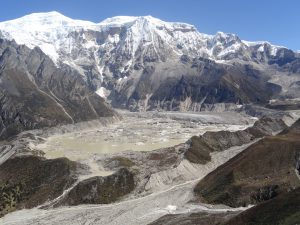Clean air plans prepared by India’s 102 non-attainment cities (those that violate the national ambient air quality standards fixed in 2009) show “significant shortcomings”, a recent study has found. The plans lack a legal mandate, transboundary coordination, funding, clear targets and accountability.
Air pollution causes more than a million deaths in India annually. India launched its National Clean Air Programme (NCAP) in January 2019 with the aim to achieve a 20-30% reduction in particulate matter (PM) concentration by 2024. If the country can achieve and sustain even 25% reduction in air pollution at the national level, it would increase India’s national life expectancy by 1.6 years.
India’s National Clean Air Programme (NCAP)
To achieve reductions nationally, the NCAP proposed that each non-attainment city prepare its specific air quality management plan. All the 102 cities have submitted these plans, and these have been approved by India’s chief pollution regulator, the Central Pollution Control Board (CPCB).
A Delhi-based think tank, the Council on Energy, Environment and Water (CEEW), and an independent research institution, Urban Emissions, together analysed the 102 plans to see how they perform on the essential components of such a plan: legal framework, sectoral reduction targets based on source contributions, the cost-effectiveness of the proposed measures, and a clear delineation of responsibilities among implementing agencies. This June 2020 analysis found:
• The city-level clean air plans stand as a collection of measures without specified goals and priorities.
• Apart from Delhi’s clean air plan, which the Supreme Court (SC) partially notified for implementation in January 2018, no other plan has a legal mandate for implementation.
• The CPCB approved the plans and directed the State Pollution Control Boards (SPCBs) to implement them. However, without a timeline mandated for implementation, any failure or delay to enforce these plans cannot be questioned.
• Over 40% of the action points listed fall under the purview of multiple agencies, which can result in fragmented accountability.
• None of the plans proposes a regional coordination mechanism, though about 30% of pollution is from sources outside of city boundaries.
• Only 25 cities’ clean air plans contain information on emissions from different polluting sources. But this information does not translate into prioritised actions listed in the plan.
Unaccountability due to lack of legal mandate
Legislation is critical for effective implementation of clean-air plans because it sets legally mandated targets, procedures and responsibilities. Without it, any failures on the part of the agencies responsible to prepare and execute clean air plans cannot be questioned, the report said.
Existing provisions under both the Environment (Protection) Act of 1986 and the Air (Prevention and Control of Pollution) Act of 1981 give state governments as well as the state pollution control boards the power to notify and/or provide legal backing to the city plans created under the NCAP. Once notified under the relevant laws, these plans would acquire a legal mandate and would need to be implemented in the given timeline.
However, apart from Delhi’s clean air plan, which the SC partially notified for implementation in January 2018, no other clean air plan has a legal mandate for implementation, the analysis found.
The CPCB approved the plans and directed the SPCBs to implement them, but without a mandated timeline, any failure or delay in implementation cannot be questioned, the analysis said.
Other than an active long-term Comprehensive Action Plan (CAP) for air pollution control, which includes traffic management, use of cleaner fuels and increased electrification of vehicles, Delhi also has an emergency response plan, the Graded Response Action Plan (GRAP), which kicks in when pollution crosses hazardous levels. It includes emergency measures to cut pollution such as an immediate ban on garbage burning and entry of trucks into the city, and closure of power plants, brick kilns and stone crushers. GRAP has been notified by the Union environment ministry under the Environment (Protection) Act of 1986.
However, GRAP pertains to cities within the National Capital Region (NCR). It was notified by the Ministry of Environment, Forest and Climate Change (MoEF&CC) and not by any of the state governments, because of Delhi’s strategic importance and the role of the central government in air quality management in the region, said Polash Mukerjee, programme lead for air quality and climate resilience at the Natural Resources Defense Council (NRDC) India, an international environmental advocacy group. “The Union environment ministry has the power to notify the 102 plans under the Environment and Air Acts, as done for Delhi’s GRAP and for various other environmental laws.”
“One of the reasons for there being no legal mandate to the city plans under NCAP so far is precisely this,to avoid accountability,” Mukerjee said, adding that the moment city plans are codified into law, the accountability for meeting their emission reduction targets will fall on the state and central pollution control boards, along with the other city and state line departments.
“It is critical to note that it was not the NCAP but rather an NGT [National Green Tribunal] order that mandated the preparation of the clean air plans (NGT 2018). This stems from the fact that the NCAP is itself a programme that cannot legally bind cities to draft clean air plans,” the report said.
The planning and execution of a nationwide programme for the prevention and control of air pollution are one of the CPCB’s main functions, as per the Air Act 1981. The same law also says that planning a comprehensive programme for the prevention and control of air pollution as well as its execution are an SPCB’s responsibility. “Despite these provisions, this was the first time that SPCBs across the country attempted to draft [clean air] plans,” said the analysis.
In countries such as the United States of America, which have been successful in managing air quality, regional or state-level plans proved to be highly successful in the country’s efforts to attain healthy air nationally. The United States Clean Air Act legally requires a general plan for all areas of the country and specific plans for all non-attainment areas.
“This legal binding is currently – and sorely – missing from India’s air quality management framework,” the analysis by CEEW and Urban Emissions said.
Multiple agencies, fragmented responsibility
“Studies have often cited the lack of coordination and integration in planning across concerned agencies and departments as the reason state- and central government-introduced schemes have failed in the past,” said the report.
All the clean air plans list the agencies responsible for each action point. But over 40% of the listed activities are shared by multiple agencies, making it difficult to hold any one agency accountable for the progress of the work, the analysis found.
Only 24% of activities from the clean air plans have been allotted to the pollution control boards. Approximately 60% of activities lie with the urban local bodies (ULBs), including municipal corporations and development authorities, and the transport department, including the traffic police. The remaining 16% lie with miscellaneous agencies, the analysis found.
This disproportionate allocation of activities to ULBs is problematic due to the country’s underdeveloped municipal finances, the report said, citing that the local bodies have limited fiscal autonomy because state governments can control their financial activities.
Indian ULBs are amongst the weakest in the world in terms of fiscal autonomy and capacity to manage growing urbanisation and rapid economic growth because the “constitutional provisions for devolution in India have been very weak”, as per a 2019 study by Indian Council for Research on International Economic Relations (ICRIER), an economic policy think-tank.
Municipal revenues/expenditures in India have been stagnant at around 1% of the country’s gross domestic product (GDP) for over a decade. By comparison, the municipal revenues and expenditures in Brazil account for 7.4% of GDP and in South Africa for 6%, the ICRIER study said.
When multiple agencies are involved, delineating responsibility and establishing a coordination mechanism is essential, the report said. The existing plans, however, “lack such a clear delineation of responsibility”.
There should be a state-level review and monitoring committee under the chief secretary of the state, a district-level committee under the district collector, and a city-level review committee under the municipal commissioner, according to the institutional framework prescribed in the NCAP to implement the clean air plans. But the NCAP does not elaborate on the composition and strength of these committees, making it difficult to assess their enforcement powers, said the report.
But the analysis found an overlap of responsibilities in the framework. For example, the pollution control action plan that concerns Uttar Pradesh’s 15 non-attainment cities identifies the Uttar Pradesh Pollution Control Board (UPPCB) as the nodal agency for monitoring the implementation of the plans. But state boards are required only to enforce actions while a state-level committee would monitor it. “This highlights an apparent overlap between the state-level review and monitoring committee [under the chief secretary] and the responsibility that the plan allocates to the UPPCB,” the analysis said.
With regard to industrial pollution management in India, pollution control boards play both monitoring and enforcement roles. These boards are empowered to issue directions requesting compliance, but they cannot levy penalties in the event of non-compliance. Only criminal courts can levy penalties, and this significantly limits the boards’ powers “since the absence of a credible threat of enforcement due to limited powers of enforcement deters compliance”, according to the analysis.
Environmental protection agencies should have the legal authority to penalise and prosecute violators. For instance, the US Environmental Protection Agency has a dedicated enforcement and compliance cell that can choose to take non-judicial or judicial action against violators as it deems fit, the report said.
No regional coordination
The contribution of outside sources to particulate concentration in cities could range from 15-50%. Yet there are no clear guidelines in any of the plans on establishing regional coordination across state boundaries.
For example, Delhi’s plan lists action points for mitigating pollution from regional sources. The governments of the NCR states and the Punjab state government have been made responsible for implementing these points; however, there is no clear delineation of responsibilities nor are there any guidelines for institutionalising coordination between the state governments, the analysis found.
China has set an example of how regional coordination can help in air quality management. China’s State Council, the country’s chief administrative authority, has supported the establishment of the Mechanism for Coordinated Prevention and Control of Air Pollution Beijing-Tianjin-Hebei (BTH) and Surrounding Areas to ensure regional coordination and achieve alignment among pollution control measures. In simple terms, China’s BTH could be compared with the NCR in India.
Through coordinated planning, common emission standards and information sharing, the average annual concentrations of PM 2.5 – a toxic particle that can sicken or kill people – in the BTH region and its surrounding areas has decreased by nearly 25% four years to 2017, said the analysis report.
Poor information about emission sources
A quantitative understanding of sources of pollution and their contribution is critical for planning emission control interventions. Source information is meant to be available via emission inventories and source apportionment studies. Such studies help with setting sector-specific emission reduction targets.Only 25 cities’ clean air plans contain collated information about emission sources, the analysis said.
Even in cases where the information was included, it has not been used to prioritise mitigation measures. Consequently, the end product turns out to be a mere compilation of activities without specific emission reduction and interim targets, according to the analysis.
The absence of source information has resulted in plans being replicated. “Our review indicated that nine states with multiple non-attainment cities have used the same set of action points and timelines across all cities,” said the report.
For example, Uttar Pradesh has 15 non-attainment cities, the second-highest after Maharashtra, and with the exception of Anpara, all have identical plans, each with the same 56 actions for transport, road dust, vehicles, waste burning, industries, and construction and demolition. All lack interim targets. Similarly, Rajasthan has five non-attainment cities and identical plans for all five, the analysis found.Only 48 cities within eight states have made plans with distinct actions and interim targets, as per the analysis.
A clear understanding of emission sources “will eliminate the tendency to over- or under-emphasise certain sectors or, conversely, ignore others”, the analysis found.
For instance, studies have identified that addressing residential emissions, such as biomass for cooking, as well as heating of single spaces and water-heating, in India, will help with achieving the National Ambient Air Quality Standards (NAAQS). Despite various government schemes regarding subsidising LPG and launching Pradhan Mantri Ujjwala Yojana (PMUY) in 2016, studies have demonstrated that the number of households that use LPG as a primary fuel is low. Yet, most action plans have targeted LPG coverage while neglecting the wider adoption of LPG as a primary fuel. “This is an example of how the residential sector has not received much attention, despite its sizeable contribution to air pollution,” said the report.
Approximately 38% of all planned activities are aimed at reducing emissions from the transportation sector alone. More than 70% are mentioned as involving overseeing, planning, proposing, preparing, investigating, identifying, ensuring, strengthening, training, studying and engaging. Meanwhile, less than 30% of the interventions call for physically manifested control options, found the analysis.
About 56 cities’ clean air plans include conducting source apportionment studies among their action points, it added. Source apportionment is a technique used to relate emissions from various pollution sources to air pollution concentrations at a given location and for a given time period
Lack of funds for clean air action plan
It is critical to estimate the costs associated with the proposed measures as this would help evaluate the cost-effectiveness of competing control options, thereby helping prioritise action, the report said.
Estimating the cost of proposals can also help cities and states determine their budgets as well as whether additional revenue streams will be needed other than the conventional funding avenues, the report added.
Only nine cities’ clean air plans have listed budgetary requirements for executing the various action points. Across these nine cities, the cost of execution ranges from Indian rupees 890 million (USD 12.183 million) in Dimapur in Nagaland, which is the least densely populated city, to INRs 160,780 million (USD 2.5 million) in Mumbai in Maharashtra, the most densely populated.
The NCAP lists the preparation of state action plans that include detailed funding mechanisms for the effective implementation of city plans as an action point. While the deadline for preparing preliminary city action plans was 2019, the deadline for developing the funding mechanism is 2020; but the two should have been carried out together, said the analysis.
The implementation of city action plans can be an expensive exercise that is contingent upon the availability of funds. Central assistance can partially cover the expenditure, but state governments and municipalities will need to identify clear revenue streams to fully implement the plans.
As for central assistance, so far the financial help has been very low. In 2019-20, the government of India set aside INR 4600 million (USD 62.968 million) for all pollution control activities. In 2019-20, of the 102 non-attainment cities, the environment ministry disbursed INR 100 million for 28 cities (USD 1.368 million) with populations of one million plus and PM 10 greater than 90 µg/m³ for various components. These components include installing and commissioning continuous ambient air quality monitoring stations (CAAQMS), creating green buffer zones along roads, acquiring mechanical street sweepers, mobile enforcement units and water sprinklers, and funding public awareness and capacity building activities among other things, the report said.
The remaining non-attainment cities were allocated USD 13,689 each for those with populations smaller than 500,000, or USD 27,378 for cities with populations ranging between 500,000 and 1 million.
“It is worth noting that a CAAQMS alone costs approximately [INR] 15 million (USD 204,564),” said the report, adding that the environment ministry, therefore, needs to reconsider the funds that are being disbursed to cities.
Bhasker Tripathi is an IndiaSpend reporting fellow.
This was first published on IndiaSpend.

![An aged man carries drinking water bottles to his home; which were provided by the relief team during flood on 7th July 7, 2016 at Anil Nagar, Guwahati [image: Vikramjit Kakati India/ZUMA Wire/Alamy Live News]](https://dialogue.earth/content/uploads/2020/09/GBR13A-300x220.jpg)






